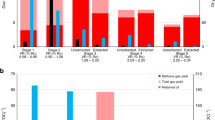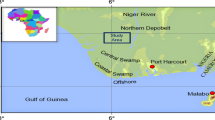Abstract
The recent interest in exploration for shale gas increases the demand for a reliable, compatible resource assessment. Many different assessment methods are used, commonly depending on types and quantity of data available, which may lead to significantly divergent results for the same shale-gas play. This study compares results obtained using performance-based and gas-in-place methodologies to assess a well-developed and active shale-gas play (Woodford Shale, Arkoma Basin, USA) and two untested, hypothetical shale-gas plays (Shublik and Brookian, Alaska North Slope, USA). Results show that the two assessment methods produce comparable results when assessment units are identically defined and similar geological constraints are used as input parameters. Inherent uncertainties are associated with both assessment methods, and these are related to aspects of shale-gas production that are not well understood. The performance-based method relies on decline trend analysis to generate distributions of estimated ultimate recovery (EUR), and uncertainty increases in cases of short production history. The gas-in-place method requires the application of a recovery factor to estimate technically recoverable resources, and both absolute values of recovery factors and their spatial variability are poorly documented, and therefore a source of uncertainty.








Similar content being viewed by others
References
Andrews, I. J. (2013). The Carboniferous Bowland Shale gas study: Geology and resource estimation. Resource document. British Geological Survey for Department of Energy and Climate Change, London. http://nora.nerc.ac.uk/503839/. Last Accessed 5 August 2015.
BGR. (2012). Abschätzung des Erdgaspotenzials aus dichten Tongesteinen (Schiefergas) in Deutschland. Bundesanstalt für Geowissenschaften und Rohstoffe, Hannover. http://www.bgr.bund.de/DE/Themen/Energie/Downloads/BGR_Schiefergaspotenzial_in_Deutschland_2012.pdf?__blob=publicationFile. Last Accessed 5 August 2015.
Bird, K. J., & Houseknecht, D. W. (2011). Geology and petroleum potential of Arctic Alaska. In A. M. Spencer, A. F. Embry, D. L. Gautier, A. V. Stoupakova, & K. Sørensen (Eds.), Arctic petroleum geology (pp. 485–499). London: Geological Society of London. doi:10.1144/M35.32.
Cardott, B. J. (2012). Thermal maturity of Woodford Shale gas and oil plays, Oklahoma, USA. International Journal of Coal Geology. doi:10.1016/j.coal.2012.06.004.
Charpentier, R. R., & Cook, T. A. (2010a). Improved USGS methodology for assessing continuous petroleum resources. U.S. Geological Survey Data Series 547, 22 p. and program. Revised November 2012. http://pubs.usgs.gov/ds/547/. Last Accessed 5 August 2015.
Charpentier, R. R., & Cook, T. (2010b). Applying probabilistic well-performance parameters to assessments of shale-gas resources. U.S. Geological Survey Open-File Report 2010-1151, 18 p. http://pubs.usgs.gov/of/2010/1151/. Last Accessed 5 August 2015.
Charpentier, R. R., & Cook, T. A. (2011). USGS methodology for assessing continuous petroleum resources. U.S. Geological Survey Open-File Report 2011-1167, 73 p. http://pubs.usgs.gov/of/2011/1167/. Last Accessed 5 August 2015.
Charpentier, R. R., & Cook, T. A. (2013). Variability of oil and gas well productivities for continuous (unconventional) petroleum accumulations. U.S. Geological Survey Open-File Report 2013-1001, 3 sheets. http://pubs.usgs.gov/of/2013/1001/. Last Accessed 5 August 2015.
Cook, T., & Charpentier, R. R. (2010). Assembling probabilistic performance parameters of shale-gas wells. U.S. Geological Survey Open-File Report 2010-1138, 17 p. http://pubs.usgs.gov/of/2010/1138/. Last accessed 5 August 2015.
Crovelli, R. A. (2012). Analytic resource assessment method for continuous (unconventional) oil and gas accumulations—the “ACCESS” method. U.S. Geological Survey Open-File Report 2012-1146, 32 p. [revised by Charpentier, R. R.]. http://pubs.usgs.gov/of/2012/1146/. Last Accessed 5 August 2015.
Curtis, J. B. (2002). Fractured shale gas systems. American Association of Petroleum Geologists Bulletin, 86(11), 1921–1938.
Demirmen, F. (2007). Reserve estimation: The challenge for the industry. Society of Petroleum Engineers, 103434, 80–89.
EIA. (2013). Technically recoverable shale oil and shale gas resources: An assessment of 137 shale formations in 41 countries outside the United States. U.S. Energy Information Administration, Washington D.C., 730 p. http://www.eia.gov/analysis/studies/worldshalegas/. Last Accessed 5 August 2015.
Ejaz, Q. (2011). Background material on natural gas resource assessments, with major resource country reports—Supplementary paper SP 2.2. In E. J. Moniz, H. D. Jacoby & A. J. M. Meggs, (Co-chairs), The future of natural gas. Cambridge, MA, MIT. http://mitei.mit.edu/publications/reports-studies/future-natural-gas. Last Accessed 5 August 2015.
Faraj, B., Williams, H., Addison, G., & McKinstry, B. (2004). Gas potential of selected shale formations in the Western Canadian sedimentary basin. GasTIPS, 10(1), 21–25. http://204.154.137.14/technologies/oil-gas/publications/GasTIPS/GasTIPS-Winter04.pdf#page=21. Last Accessed 5 August 2015.
Featherston, W. A., Jiang, B., Drum, D., & O´Connor, M. (2011). NYT shale gas allegations seem exaggerated. Resource document. UBS Investment Research. http://s3.amazonaws.com/zanran_storage/www.anga.us/ContentPages/2520050971.pdf. Last Accessed 5 August 2015.
Gault, B., & Stotts, G. (2007). Improve shale gas productions forecasts. Resource document. Hart’s Exploration and Production. http://www.epmag.com/improve-shale-gas-production-forecasts-724656. Accessed 5 August 2015.
U.S. Geological Survey Oil and Gas Assessment Team. (2012). Variability of distributions of well-scale estimated ultimate recovery for continuous (unconventional) oil and gas resources in the United States. U.S. Geological Survey Open–File Report 2012–1118. http://pubs.usgs.gov/of/2012/1118/. Last Accessed 5 August 2015.
Harvey, T., & Gray, J. (2010). The unconventional hydrocarbon resources of Britain’s onshore basins - shale gas. Resource document. British Geological Survey for Department of Energy and Climate Change. https://www.gov.uk/government/uploads/system/uploads/attachment_data/file/367287/Shalegas_uk.pdf. Last Accessed 5 August 2015.
Houseknecht, D. W., Burns, W. M., & Bird, K. J. (2012a). Thermal maturation history of Arctic Alaska and the southern Canada Basin. In N. B. Harris & K. E. Peters (Eds.), Thermal history analysis of sedimentary basins—Methods and case histories (pp. 199–219). SEPM (Society for Sedimentary Geology) Special Publication 103: Tulsa, OK.
Houseknecht, D. W., Coleman, J. L., Milici, R. C., Garrity, C. P., Rouse, W. A., Fulk, B. R., Paxton, S. T., Abbott, M. M., Mars, J. C., Cook, T. A., Schenk, C. J., Charpentier, R. R., Klett, T. R., Pollastro, R. M., & Ellis, G. S. (2010). Assessment of undiscovered natural gas resources of the Arkoma Basin province and geologically related areas. U.S. Geological Survey Fact Sheet 2010-3043. http://pubs.usgs.gov/fs/2010/3043/pdf/FS10-3043.pdf. Last Accessed 5 August 2015.
Houseknecht, D. W., Rouse, W. A., & Garrity, C. P. (2012b). Arctic Alaska shale-oil and shale-gas resource potential. Arctic Technology Conference OTC 23796.
Houseknecht, D. W., Rouse, W. A., Garrity, C. P., Whidden, K. J., Dumoulin, J. A., Schenk, C. J., Charpentier, R. R., Cook, T. A., Gaswirth, S. B., Kirschbaum, M. A., & Pollastro, R. M. (2012c). Assessment of potential oil and gas resources in source rocks of the Alaska North Slope, 2012. U.S. Geological Survey Fact Sheet 2012-3013. http://pubs.usgs.gov/fs/2012/3013/pdf/fs2012-3013_2-28-2012.pdf. Last Accessed 5 August 2015.
Houseknecht, D. W., Rouse, W. A., Paxton, S. T., Mars, J. C., & Fulk, B. (2014). Late Devonian—Mississippian stratigraphic framework of the Arkoma basin and distribution of potential source-rock facies in the Woodford-Chattanooga and Fayetteville-Caney shale-gas systems. American Association of Petroleum Geologists Bulletin. doi:10.1306/03031413025.
Hulm, E. J. (1999). Subsurface facies architecture and sequence stratigraphy of Eileen Sandstone, Shublik Formation, and Sag River Sandstone, Arctic Alaska. Unpublished MSc. thesis, University of Alaska Fairbanks, 105 p., 13pl.
IEA. (2009).World energy outlook 2009. Resource document. International Energy Agency. http://www.worldenergyoutlook.org/media/weowebsite/2009/WEO2009.pdf. Last Accessed 5 August 2015.
Ikonnikova, S., Browning, J., Gulan, G., Potter, E., Fu, Q., Horvath, S., Patzek, T., Male, F., Medlock, K., Seithleko, L, & Tinker, S. (2012). Barnett Shale—Resources, reserves and future production. 31th USAEE/IAEE, Austin, Texas. http://www.usaee.org/usaee2012/submissions/Presentations/Svetlana%20presentationMorning.pdf. Last Accessed 5 August 2015.
Kelly, L. N., Whalen, M. T., McRoberts, C. A., Hopkin, E., & Tomsich, C. S. (2007). Sequence stratigraphy and geochemistry of the Upper Lower trough Upper Triassic of northern Alaska: Implications for paleo redox history, source rock accumulation, and paleoceanography. Alaska Geological and Geophysical Surveys Report of Investigations 2007-1. http://www.dggs.alaska.gov/pubs/id/15773. Last Accessed 5 August 2015.
Kuuskraa, V. A. (2009). Worldwide gas shales and unconventional gas: A status report. Resource document. Advanced Resources International Inc. http://www.adv-res.com/pdf/Kuuskraa%20Condensed%20Worldwide%20Uncon%20Gas%2012_12_09.pdf. Accessed 5 August 2015.
Kuuskraa, V., Stevens, S., Van Leeuwen, T., & Moodhe, K. (2011). World shale gas resources: An initial assessment of 14 regions outside the United States. Resource document. Advanced Resources International Inc. http://www.adv-res.com/pdf/ARI%20EIA%20Intl%20Gas%20Shale%20APR%202011.pdf. Accessed 5 August 2015.
McGlade, C., Speirs, J., & Sorrell, S. (2013). Methods of estimating shale gas resources—Comparison, evaluation and implications. Energy. doi:10.1016/j.energy.2013.05.031.
Mohr, S. H., & Evans, G. M. (2011). Long term forecasting of natural gas production. Energy Policy. doi:10.1016/j.enpol.2011.04.066.
Pearson, I., Zeniewski, P., Gracceva, F., & Zastera, P. (2012). Unconventional gas: Potential energy market impact in the European Union. Resource document. European Commission Joint Research Center. https://ec.europa.eu/jrc/sites/default/files/reqno_jrc70481_unconventional_gas_potential_energy_market_impacts_in_the_european_union.pdf. Last Accessed 5 August 2015.
Peters, K. E., Magoon, L. B., Bird, K. J., Valin, Z. C., & Keller, M. A. (2006). North Slope Alaska: Source-rock distribution, richness, thermal maturity and petroleum charge. American Association of Petroleum Geologists Bulletin. doi:10.1306/09210505095.
PGI. (2012). Assessment of shale gas and shale oil resources of the Lower Paleozoic Baltic-Podlasie-Lublin basin in Poland. Resource document. Polish Geological Institute. http://www.pgi.gov.pl/en/mineral-resources-en/shale-gas/4744-shale-gas-estimates.html. Last Accessed 5 August 2015.
Robison, V. D., & Dawson, W. C. (2001). Lithofacies, organic geochemistry, petrology, and sequence stratigraphy of the Ellesmerian sequence: Integrated analyses of Tenneco Phoenix #1 cores, North Slope, Alaska. In D. W. Houseknecht (Ed.), NPRA core workshop—Petroleum plays and systems in the National Petroleum Reserve—Alaska (pp. 111–124). (Society for Sedimentary Geology) Core Workshop 21: Tulsa, OK.
Sandrea, R. (2012). Evaluating production potential of mature US oil, gas shale plays. Oil & Gas Journal. 12/03/2012. http://www.ogj.com/articles/print/vol-110/issue-12/exploration-development/evaluating-production-potential-of-mature-us-oil.html. Last Accessed 5 August 2015.
Sandrea, R., & Sandrea, I. (2014). New well-productivity data provide US shale potential insights. Oil & Gas Journal. 03/11/2014. http://www.ogj.com/articles/print/volume-112/issue-11/drilling-production/new-well-productivity-data-provide-us-shale-potential-insights.html. Last Accessed 5 August 2015.
Schenk, C. J., & Nelson, P. H. (2015). Geologic model and assessment of potential unconventional (tight) gas resources in upper Cook Inlet basin, south-central Alaska. In C. J. Schenk (Compiler), Assessment of unconventional (tight) gas resources in upper Cook Inlet basin, south-central Alaska (chapter 1). U.S Geological Survey Digital Data Series 69–AA. http://pubs.usgs.gov/dds/dds-069/dds-069-aa/REPORTS/DDS-69-AA-Chapter1.pdf. Last Accessed 5 August 2015.
Schmoker, J. W. (2005). U.S. Geological Survey assessment concepts for continuous petroleum accumulations. U.S. Geological Survey Digital Data Series DDS–69–D, Ch. 13. http://certmapper.cr.usgs.gov/data/noga00/natl/text/CH_13.pdf. Last Accessed 5 August 2015.
Schmoker, J. W., & Klett, T. R. (2005). U.S. Geological Survey assessment concepts for conventional petroleum accumulations. U.S. Geological Survey Digital Data Series DDS–69–D, Ch. 19. http://certmapper.cr.usgs.gov/data/noga00/natl/text/CH_19. Last Accessed 5 August 2015.
TNO (2009). Inventory non-conventional gas. Resource document. Netherlands Organization for Applied Scientific Research TNO-034-UT-2009-00774/B. https://www.ebn.nl/wp-content/uploads/2014/11/200909_Inventory_non-conventional_gas.pdf. Accessed 5 August 2015.
Acknowledgments
We appreciate constructive reviews of the manuscript by two anonymous Natural Resources Research reviewers and Ricardo Olea (USGS).
Author information
Authors and Affiliations
Corresponding author
Rights and permissions
About this article
Cite this article
Stueck, H., Houseknecht, D., Franke, D. et al. Shale-Gas Assessment: Comparison of Gas-In-Place Versus Performance-Based Approaches. Nat Resour Res 25, 315–329 (2016). https://doi.org/10.1007/s11053-015-9283-y
Received:
Accepted:
Published:
Issue Date:
DOI: https://doi.org/10.1007/s11053-015-9283-y




